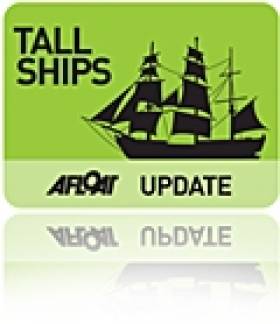Displaying items by tag: Sail Training International.
€10,000 Tall Ships Bursary for Irish Sailing Trainees
A new sailing body that claims it will ensure the continuation of the long standing Irish Tall Ships maritime tradition of youth sail training was launched at a ceremony in Dublin Port this afternoon.
The newly established Sail Training Ireland for Youth Development (STIYD) was officially launched by Nigel Rowe, President and Chairman of Sail Training International.Following the sinking of the Asgard II and the decision to wind up Coiste An Asgard, the future of sail training in Ireland had been uncertain but STIYD will now ensure the continuation of the long standing Irish maritime tradition. More Asgard II News.
At the launch Nigel Rowe also announced that Sail Training International had awarded STIYD with a bursary of €10,000 to help fund the participation of young Irish trainees in The Tall Ships Races 2011. Mr. Rowe remarked "It is wonderful to see Sail Training Ireland for Youth Development emerge from all the uncertainties and anxieties that followed the demise of Coiste an Asgard. The commitment and enthusiasm of the people who have made this happen will ensure its success, and they will have the full support of the international sail training community. With Waterford as a host port for this year's Tall Ships Races we have already committed more than €10,000 to help fund the participation of young Irish trainees."
The aims and objectives of Sail Training Ireland are to promote the development and education of young men and women through the Sail Training experience regardless of nationality, culture, religion, gender or social background as well as to sponsor and support sea-going trainees. Sheila Tyrrell, Chair of the steering group, who has a long history with sail training and in particular the Asgard remarked "We are delighted that we are in a position to formally launch the association, we are now taking applications for bursaries to allow young people to participate in the Tall Ships Race visiting Waterford later this year, and are also recruiting a manager to help manage the affairs of the association."
Also in attendance at the launch was Mr. Clayton Love Jnr., founding member of Coiste An Asgard and former President of the ISA. During the afternoons formalities Mr. Love Jnr. was officially awarded Honorary membership of STIYD in recognition of his outstanding contribution to sail training in Ireland.
Sail Training Ireland is also seeking to appoint a part-time manager to help with the development of a business plan and the day to day running of the organisations affairs. Further information on the position and a full job description can be found on the STI website www.irishsailtraining.com. Closing date for applications is Friday 22nd April.
The launch, sponsored by Arklow Shipping, was hosted by Dublin Port who are one of a number of ports supportive of the project.
All the latest Tall Ships News from Ireland.
Back from the deep. Should Asgard's bell ring out in Waterford? You decide. Poll.
























































